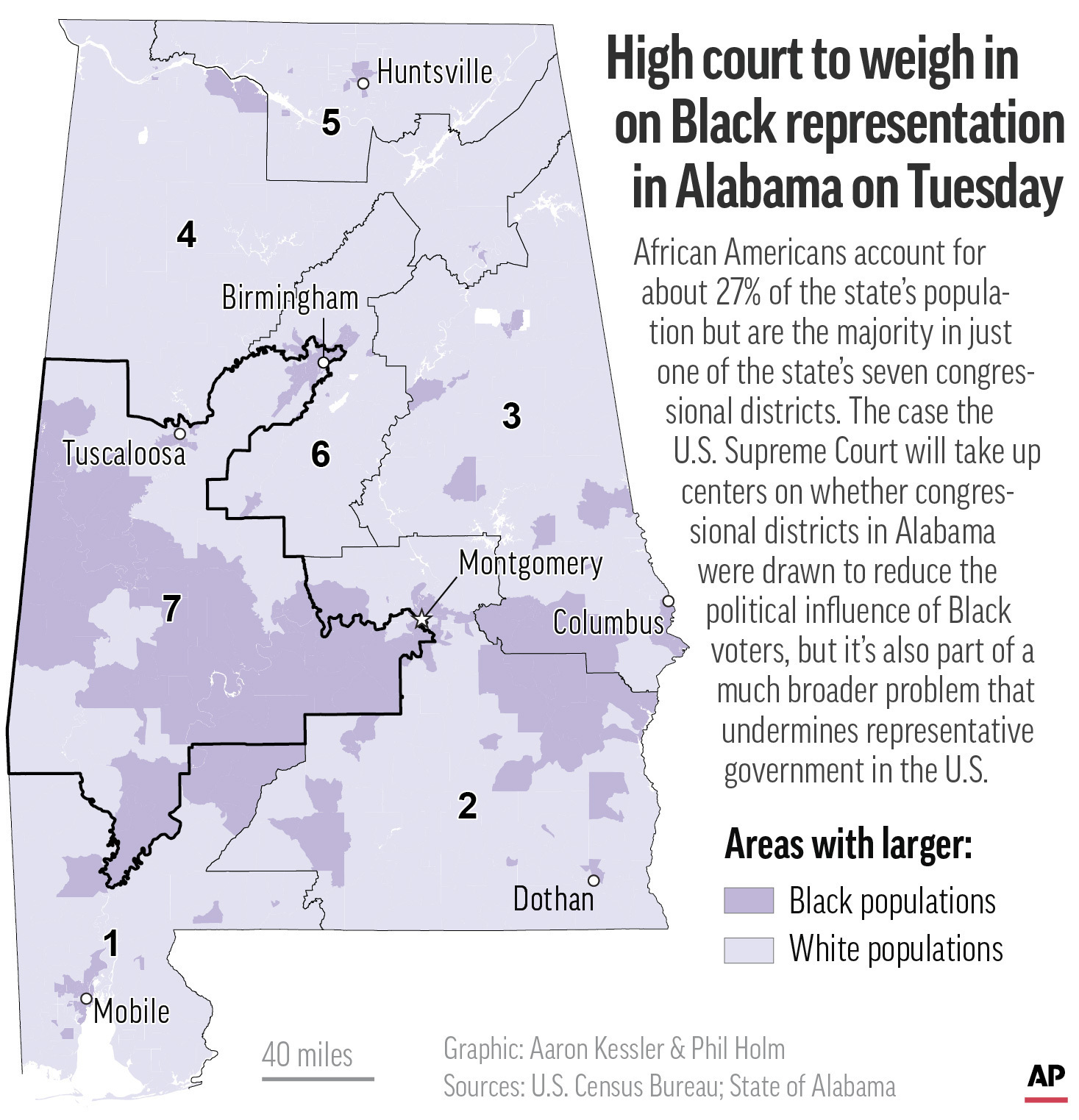Supreme Court justices heard oral arguments Tuesday over a major case that could bolster or weaken the Voting Rights Act as Alabama seeks to defend a GOP-drawn electoral map that lower court judges ruled was limiting the power of the state’s black voting bloc.
Plaintiffs who sued the state, which include the NAACP‘s Legal Defense Fund, are seeking to force Alabama to create a second black-majority district after Republicans drew only one for the state’s 2021 congressional redistricting map.
The group cites that 27% of the state’s population is black and therefore justifies the formation of a second district under Section 2 of the Voting Rights Act.
“Section Two … is not an intent test or about putting on racial blinders. It is about equal opportunity, opportunity that Alabama’s map denies Black voters,” said Deuel Ross, senior counsel for the plaintiffs challenging the state’s map.
SUPREME COURT’S ALABAMA REDISTRICTING CASE WILL TEST JUSTICE JACKSON’S INFLUENCE

Conversely, Alabama Attorney General Steve Marshall contends that the equal protection clause of the Constitution’s 14th Amendment prevents lawmakers from making distinctions based explicitly on race or gender.
Alabama Solicitor General Edmund LaCour argued Tuesday that the state legislature drew the map “in a lawful race-neutral manner.”
Several of the high court’s 6-3 majority of Republican-appointed justices including Samuel Alito appeared to show a willingness to make it harder for plaintiffs to argue that more majority-minority districts should be added just because challengers are able to create thousands of computer-generated models that show such possibilities. If Alabama is successful, other states could defend against lawsuits if they can prove they utilized a race-neutral standard during the map-drawing process.
Notably, the high court’s new term marks a landmark occasion in which two black justices, Republican-appointed Clarence Thomas and Democratic-appointed Ketanji Brown Jackson, were along the nine-member bench to discuss racial issues.
Thomas had the first question on Tuesday for Lacour, asking, “What is the alternative to using race as a comparator?”
LaCour said that there should be other benchmarks, but Justice Elena Kagan, a member of the liberal bloc, argued that alternatives such as “race-neutral” benchmarks have never been accepted under the Supreme Court’s precedent.
“Under our precedent, it’s kind of a slam dunk,” Kagan said, suggesting that Alabama is asking the justices to change the way they rationalize Section 2.
Jackson questioned LaCour about the framers’ intent regarding the 14th Amendment, saying they didn’t intend it to be “race-neutral or race-blind.”
The 14th Amendment “was drafted to give a constitutional foundation for a piece of legislation that was designed to make people who had less opportunity and less rights [become] equal to white citizens,” Jackson said. She pressed on: “I’m trying to understand why that violates the 14th Amendment, given the history and background of the 14th Amendment.”
Many court watchers saw Jackson’s citation of the 14th Amendment’s draft stages as an assertive response to the “originalist” standpoint conservative justices often point to when defining their philosophy. However, the conservative Judicial Crisis Network’s President Carrie Severino said Jackson’s history is “not quite correct.”
“The understanding at the time was, was not so much about we need to be race-conscious, but we need to be conscious about correcting the harms against specific people,” Severino said, citing a book by Judicial Crisis Network senior counsel Frank Scaturro. The book details how the Supreme Court’s jurisprudence toward the 13th-, 14th-, and 15th-Amendment protections became more narrowed during the post-Reconstruction era after 1877.
Tuesday’s arguments stem from a January lower court ruling that ordered Alabama’s map to be redrawn because it diminished the influence of black voters by concentrating their voting power into a single House district while distributing the rest of the black population in other districts at levels too small to form a majority.
Justices ruled 5-4 in February to place the lower court order on hold, allowing Alabama to implement its initial plan for the midterm elections. President Joe Biden’s administration condemned the move, while the solicitor general for the Justice Department also argued alongside the plaintiff’s counsel against Alabama’s map on Tuesday.
It’s not immediately clear whether any of the conservative justices were swayed by the plaintiff’s arguments on Tuesday. Republican-appointed Chief Justice John Roberts sided with the liberal bloc’s dissent in the February decision, which allowed Alabama’s map to take effect, though he has previously voted to limit the reach of the Voting Rights Act.
CLICK HERE TO READ MORE FROM THE WASHINGTON EXAMINER
A decision in the consolidated cases, Merrill v. Milligan and Merrill v. Caster, is expected by the end of June.
The justices will also take up two more cases this term in what conservative lawyers described as race-neutral arguments against preexisting precedents, including whether to end affirmative action in college admissions and whether to strike down a portion of a law that issues preference to Native American families seeking to adopt Native American children.

